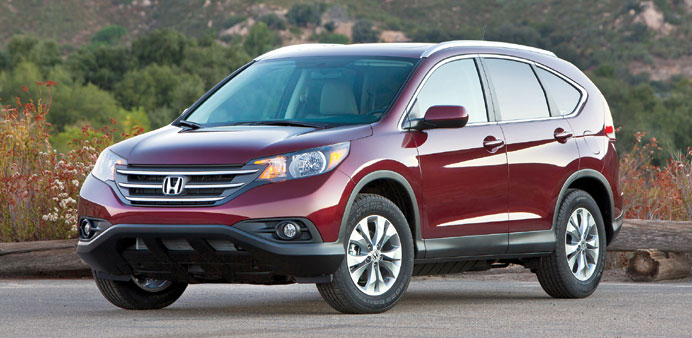By G Chambers Williams III
One of the first of the now-popular class of vehicles known as crossovers, the compact Honda CR-V deservedly has always been a star in its niche, even as the competition grew.
Introduced originally for 1997, the CR-V last year entered its fourth generation, with an all-new design that gave it a sleeker, less boxy exterior; a more refined interior; and some new technology to help it keep up with the tech-savvy buyers to whom the CR-V consistently appeals.
For 2013, prices begin at $22,795 (in the US) for the base front-wheel-drive LX version, and run as high as $30,295 for the top-of-the-line EX-L version with all-wheel drive and the navigation package. The “L” designation stands for “leather.”
In between are the LX all-wheel-drive version and a variety of EX (no leather) and EX-L models, with either two- or four-wheel drive.
Our tester was the top model, the EX-L all-wheel drive with the built-in navigation system. This model was equipped with everything one can buy on the CR-V except the rear-seat entertainment system, which apparently is not available on models that include the nav system.
There’s also an upscale version of the CR-V sold under the Acura name — the RDX. It has its own unique exterior and interior styling, but essentially is just a fancier CR-V underneath, although it is about five inches longer. It comes with either front- or all-wheel-drive.
The CR-V has room for up to five passengers. No third row has ever been offered in this model, although its biggest competitor, the Toyota RAV4, did have a small third-row seat in its previous generation; it lost that feature with a complete redesign for 2013.
Other competitors in this burgeoning class include the Ford Escape, which was also redesigned for 2013 and now looks a lot like the CR-V; Nissan Rogue; Mitsubishi Outlander and Outlander Sport; Subaru Forester; the new Subaru XV Crosstrek; Subaru Outback; Buick Encore; Kia Sportage; Hyundai Tucson; Jeep Patriot and Compass; Mazda CX-5; Volkswagen Tiguan; Chevrolet Equinox; and GMC Terrain.
Even with all of that competition, the CR-V holds its own in the market. Although sales are off slightly so far this year from last year’s totals, Honda sold 281,652 of the CR-V during 2012, a 29% increase from 2011. That outpaced the RAV4 by more than 100,000 sales and made the CR-V one of the US’ best-selling vehicles for the year.
The CR-V also garnered some accolades, such as making Kelley Blue Book’s list of “Top 10 Family Cars,” among others.
Its popularity is based on a variety of attributes, including comfort, safety, reliability and even its fuel economy — 23 mpg city/31 highway for the front-drive models and 22/30 for the all-wheel drives.
It’s not best in class for mileage, though. Mazda claims 26/35 with the manual-transmission version of its CX-5, and 26/32 with the automatic version. Still, the CR-V’s fuel economy is comparable to most of its competitors, even though its standard five-speed automatic transmission is getting a bit dated; most vehicles in this class have a six-speed, which generally gives slightly better highway mileage.
Under the hood of all CR-V models is a 2.4-litre four-cylinder engine, rated at 185hp and 163 foot-pounds of torque. We found it to have plenty of power for this vehicle, even with a couple of people in the back seat and some luggage in the rear.
We gave it a run on some hills, too, and the CR-V never felt underpowered, although the cruise control didn’t hold the speed on the uphill runs as precisely as I expected — it dropped as much as 5mph at times.
Among standard equipment are leather seats/steering wheel/shift knob; heated front seats (10-way power-adjustable for the driver); a power tilt/slide sunroof; a rearview camera built into the voice-activated navigation system; a premium audio system with seven speakers (including subwoofer); power windows/mirrors/door locks with remote; and dual-zone automatic climate control.
Honda says the new exterior design was intended to give the CR-V a more aggressive look, but to me it’s actually softer than before, with lines that seem to flow. It’s remarkably similar in appearance to both the Escape and RAV4.
There is a new horizontal three-bar grille and deep-set multi-reflector headlights, bolder fender flares and a lower rear roofline with a liftgate that tilts slightly forward at the top.
Inside, the CR-V is now more carlike, and the seats are lower than before. Outward visibility is still excellent, though.
As longtime CR-V owners, we noticed how quiet the newest generation is, even at high freeway speeds. Honda attributes that to a more-rigid body structure, improved suspension isolation, more insulation, and better aerodynamics — including underbody covers and a rear spoiler.
During our test, we averaged about 27mpg in a mix of highway and city driving — with the highway miles about 70% of the total. That was using the provided ECON mode, which sets transmission shift points to optimise fuel economy rather than provide jackrabbit starts.
Safety features include electronic stability control, four-wheel antilock disc brakes with brake assist, roof-mounted side-curtain air bags with rollover sensor, and front seat-mounted side air bags. — Fort Worth Star-Telegram/MCT
l (Price and technical specifications may vary in locally available models)
G

